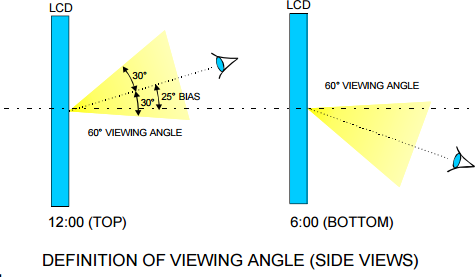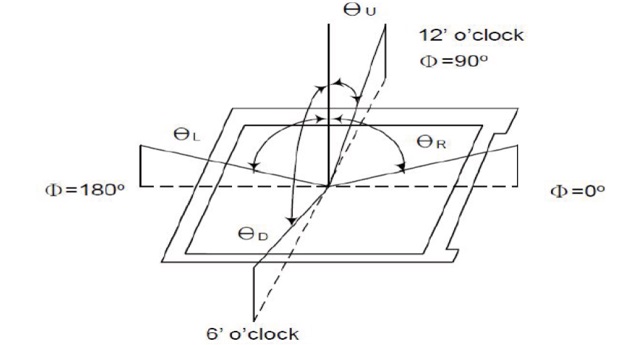LCD Viewing Angle
Viewing angle is a very important factor when evaluating LCD display's performance. Understanding how to locate the optimum viewing angle and choose the right LCD display will make your product looks sharp without extra cost.
What is LCD Viewing Angle?
LCD viewing angle is the maximum angle from which customer can view the screen well. "Viewing well" is commonly recognized as having at least 10:1 contrast and without grayscale inversion.
At time of manufacturing, LCD manufacturer designs LCD panel in a way that it is best viewed from an angle (called Bias) offset from the perpendicular by certain degrees, to accommodate as many applications as possible. Viewing angle is the angle covers both side of Bias angle, where the LCD is still "viewing well".

When reading an LCD's specification, you will see the term "viewing direction". Viewing direction is defined following the format of a clock. Like figure below, Z axis is Normal, X axis is Horizontal and Y axis is Vertical. An LCD's viewing angle "above" Z axis is having 12 o'clock viewing direction. So 6 o'clock viewing direction LCD is best viewed from "below" Z axis.

Theoretically, LCD manufacturer can produce LCD with 3, 12, 9 and 6 o'clock viewing direction. But in practice, we usually look at LCD display from 12 or 6 o'clock angle.
Improve LCD Viewing Angle
Using a simple TN type TFT LCD as example, its viewing angle is typically 45~65 degrees. Adding extra wide polarizer film (EWP) to the TN type LCD, the viewing angle may be increased about 10 degrees. Similarly, an O-film enhancement polarizer will widen the viewing angle to 75 degree in each direction. However, these enhancements bring along contrast reduction. Adjusting LCD contrast is necessary.
Choosing an advanced cell structure is another way to improve LCD viewing angle. IPS and VA type LCD panels have wider viewing angle than a TN ones.
Conclusion
Using a liquid crystal display with proper viewing angle is very important to your product's success. And we should keep in mind that optimized contrast is crucial, too. Both parameters define the visual appearance of the LCD display and the appeal of your product. Choices are based on cost performance trade offs.
For example, if your project requires a wide viewing angle 2.4" TFT LCD. TN TFT panel with O-film solution might be better than using IPS LCD. Topway engineers are here to help you making those design decisions.
